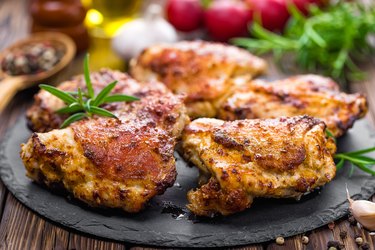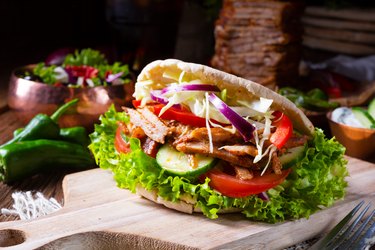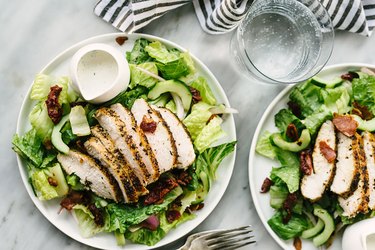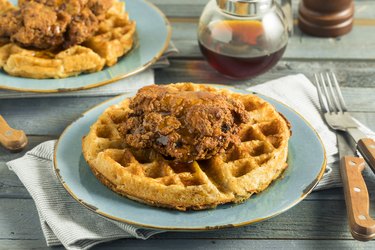
When cooked the right way, chicken is moist, tender and flavorful. But if you make some of these common cooking mistakes, you may end up with dry, chewy and bland chicken — and that simply won't fly.
Cooking poultry can be intimidating, but it doesn't have to be. Here's how to fix the most common mistakes when cooking chicken, according to registered dietitians.
Video of the Day
Video of the Day
1. You Defrost Frozen Chicken at Room Temperature
Do you set your frozen chicken on the counter to defrost? Well, you should never thaw frozen chicken on the counter, according to the USDA.
"Keeping chicken at room temperature for even a few hours or overnight allows potentially hazardous bacteria to grow and thrive," says Toby Amidor, RD, CDN, a dietitian and best-selling author of eight cookbooks. "Cooking the chicken may not be able to destroy the harmful microorganisms, and this can potentially make someone sick."
Fix it: Instead of leaving your frozen chicken to defrost on the counter, transfer it from the freezer to the refrigerator up to 2 nights before it's needed.
Amidor recommends placing it in a container to collect any juices and storing the chicken on the fridge's bottom shelf. If it's still frozen by the time you need it, place the chicken in a bowl of cold water. Make sure the chicken is stored in airtight packaging and change out the water every 30 minutes, she says.
2. You Don’t Marinate the Chicken
Failing to marinate the chicken ahead of time can result in a bland bird. Even if you season your chicken, dry seasoning doesn't always stick, which means you won't get lots of flavor.
"The most common mistake I hear from budding home chefs is that chicken is too bland," says registered dietitian Brenda Peralta, RD. "It doesn't have any flavor, and it is just plain dull."
Fix it: Banish tasteless chicken by marinating it ahead of time. This can save you time, and the marinade increases moisture to prevent dryness.
"Marinating adds a variety of flavor to your chicken, so you don't get bored of the same recipe every time," Peralta says.
She recommends making a marinade with rosemary, garlic, onion and lemon juice and letting it marinate in the fridge overnight. The acidity in the lemon juice helps break down the fibers in the chicken, softening tough cuts of meat. It also infuses flavor — the longer you let it marinate, the more intense the flavor.
3. You Don’t Tenderize the Meat
If your chicken comes out tough, it may be because you forgot to pound it out. This tenderizes the meat, making it more enjoyable to eat.
"If you want tender meat, the best thing you can do is to pound the meat," Peralta says. "By pounding the meat, you soften the tissue, leaving a juicy and tender chicken filet."
Fix it: To tenderize your chicken, you'll need to remove any bones and wrap it in plastic. Use a meat mallet or rolling pin to beat the chicken. Marinate the soft chicken after for the best texture and taste.
Pounding chicken also flattens it and encourages even cooking. If you don't tenderize your chicken, you may have pieces that are different sizes that can cook at different speeds.
4. You Cook Pieces of Different Sizes at the Same Time
Chances are your pieces of chicken vary in size. Or perhaps you have different cuts of chicken on hand, such as chicken breasts and drumsticks. While you may be tempted to cook these in the same pan, that's not a good idea.
"Smaller cuts of chicken will cook in less time, possibly at a lower temperature compared to thicker cuts," says dietitian Jenna Volpe, RDN, LD. "Trying to cook different sized pieces of chicken at the same temperature and for the same amount of time will likely result in some pieces of chicken that are overcooked, and other pieces that are undercooked."
Fix it: When you're cutting your chicken, make sure they're uniform in size and shape. If you're purchasing chicken cuts, select the same cut across the board.
This allows the chicken to cook at the same time, so you don't end up with pieces that are over- or under-cooked. Ensuring your chicken is cooked just right yields a better taste and texture.
5. You Don’t Use a Meat Thermometer
A meat thermometer isn't only for professional kitchens or for special occasions only, such as cooking a turkey on Thanksgiving. Dietitians want you to get used to using a meat thermometer all the time.
"You can't rely on visual cues to know when your chicken is done," Amidor says. "Using a thermometer is the only sure way to know if your chicken is cooked properly."
Fix it: Invest in a meat thermometer ($7, Amazon). You'll want to use it to check the thickest part of the chicken — the minimum internal temperature of all types of cooked poultry should be 165 degrees Fahrenheit, per the U.S. Department of Health & Human Services.
If that internal temperature hasn't been met, continue cooking the chicken and check again until it has because no one wants to cut into pink chicken.
6. You Choose Thick Cuts of Meat
Chicken comes in various shapes and sizes — chicken breast cutlets can be especially large — but selecting your cuts wisely may lessen the chances of making a mistake.
"Choosing a very thick cut of chicken breast makes it difficult to cook it through properly, resulting in raw or undercooked chicken," Volpe says.
"Not only is this unappealing from a taste and texture standpoint, but it's also unsafe in that undercooked chicken is a breeding ground for pathogens like E. coli, which can cause foodborne illness."
Fix it: Volpe recommends cutting the chicken into smaller pieces, which will cook more evenly and thoroughly. She also recommends pounding the meat to flatten it.
If you insist on cooking large pieces of chicken, use a meat thermometer to ensure they are fully cooked through.
7. You Use Really High Heat
Sautéeing your chicken is a sound cooking method, but make sure your stove isn't turned up too high. It's easy to crank up the heat in hopes your chicken will cook faster, but this is a common mistake with unsafe consequences.
"This results in an unfortunate combination of chicken that is undercooked internally and overcooked or burned on the outside," Volpe says. Boiling your chicken on high heat can also yield these unwanted results. "It can result in tough, dry and overcooked chicken if it is sliced too thin."
Fix it: Don't be so quick to turn up the flame whether you're sautéeing or boiling your chicken. If you're new to cooking chicken, follow a recipe closely. The recipe instructions will let you know the appropriate heat setting and cook time.
This applies to all methods of cooking chicken. Turning up the temperature of the oven, for example, won't yield the results you're looking for.
If you're looking to cut down on time, pan-roasting chicken is considered one of the fastest cooking methods — just make sure to use medium-high heat, according to the University of Southern California.
8. You Don’t Use a Lid
Do you put a lid on your pot or pan when cooking chicken? If your chicken comes out dry, this may be the problem.
"Another common mistake is cooking without a lid, which results in dry chicken," says Peralta. She suggests leaving the lid on to trap some steam and tenderize the meat. This also prevents oil and grease from making a mess on your cooking surface.
Fix it: The solution is simple but effective: "Covering with a lid on the pot or pan allows for super moist chicken," Peralta says. "This prevents moisture from evaporating and locks in the juiciness of the chicken."
If you want even juicier chicken, she recommends adding some sauce or using a marinade.
9. You Buy Conventionally Raised Chicken
There are a lot of labels to learn when it comes to buying chicken. Does it matter if your chicken is organic, free-range or pasture-raised? Registered dietitian DJ Mazzoni, RD, CSCS says at least one of these labels is worth paying attention to.
He recommends purchasing pasture-raised chicken when possible. "Pastured animal products are not only ethically superior but are nutritionally superior," Mazzoni says. "Pastured meats are more nutrient-dense and have a fatty acid ratio that minimizes inflammation compared to conventionally raised meats."
If you're not familiar with the label, "pasture-raised" means that the chickens were raised in a way that's similar to how they would live in the wild. They have more freedom to roam, and they usually have a better diet as they get to peck at the soil and seeds in the ground.
Fix it: Mazzoni says pasture-raised chicken is worth the extra couple of bucks, if you can afford it. It's better for the chickens and your health.
Does this affect the flavor, too? Mazzoni thinks so. "Pastured chicken tends to have a fuller, richer taste than conventionally raised chicken," he says. "The extra exercise of chickens increases their muscle development, which is found to have a favorable effect on the flavor and texture of their meat."


